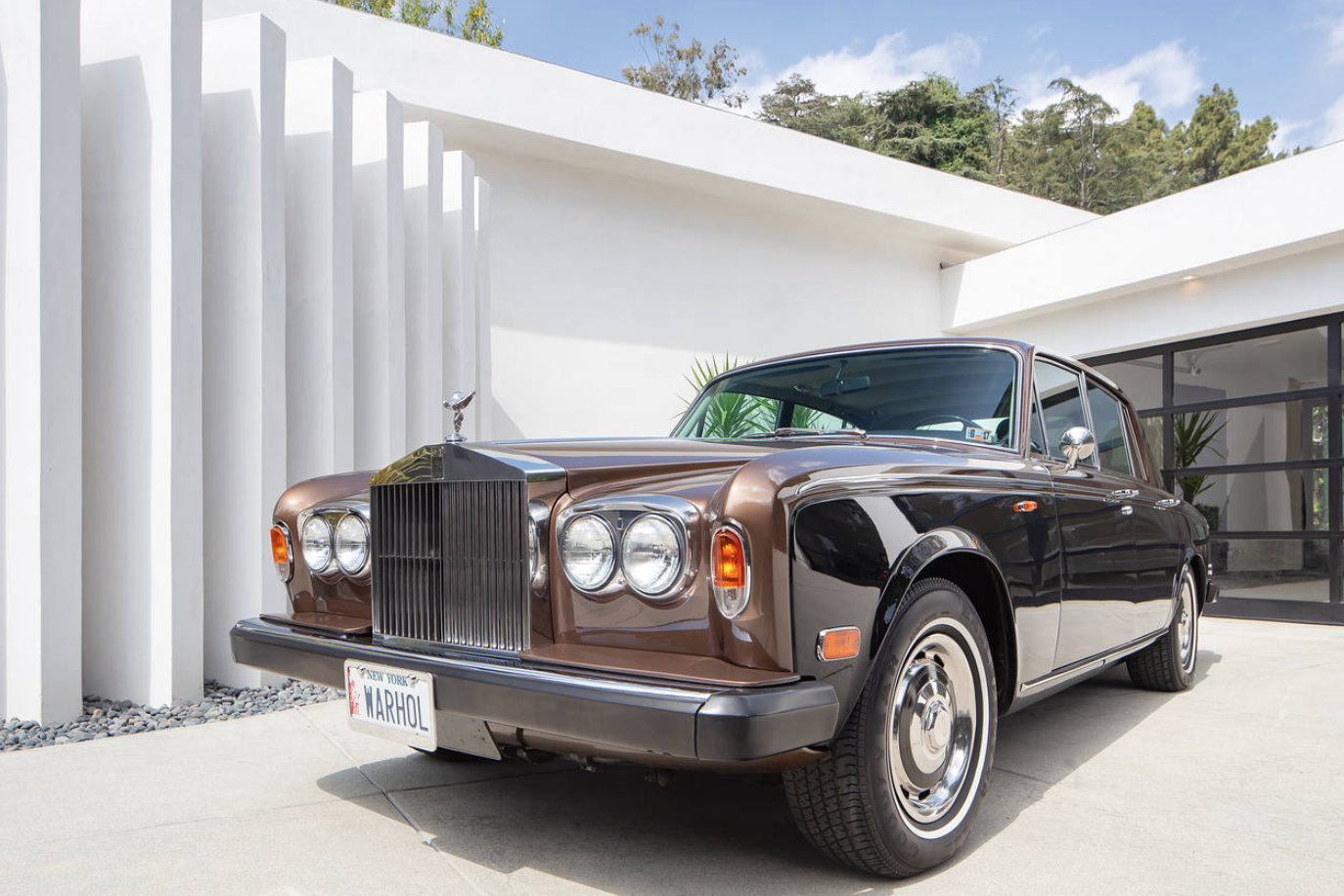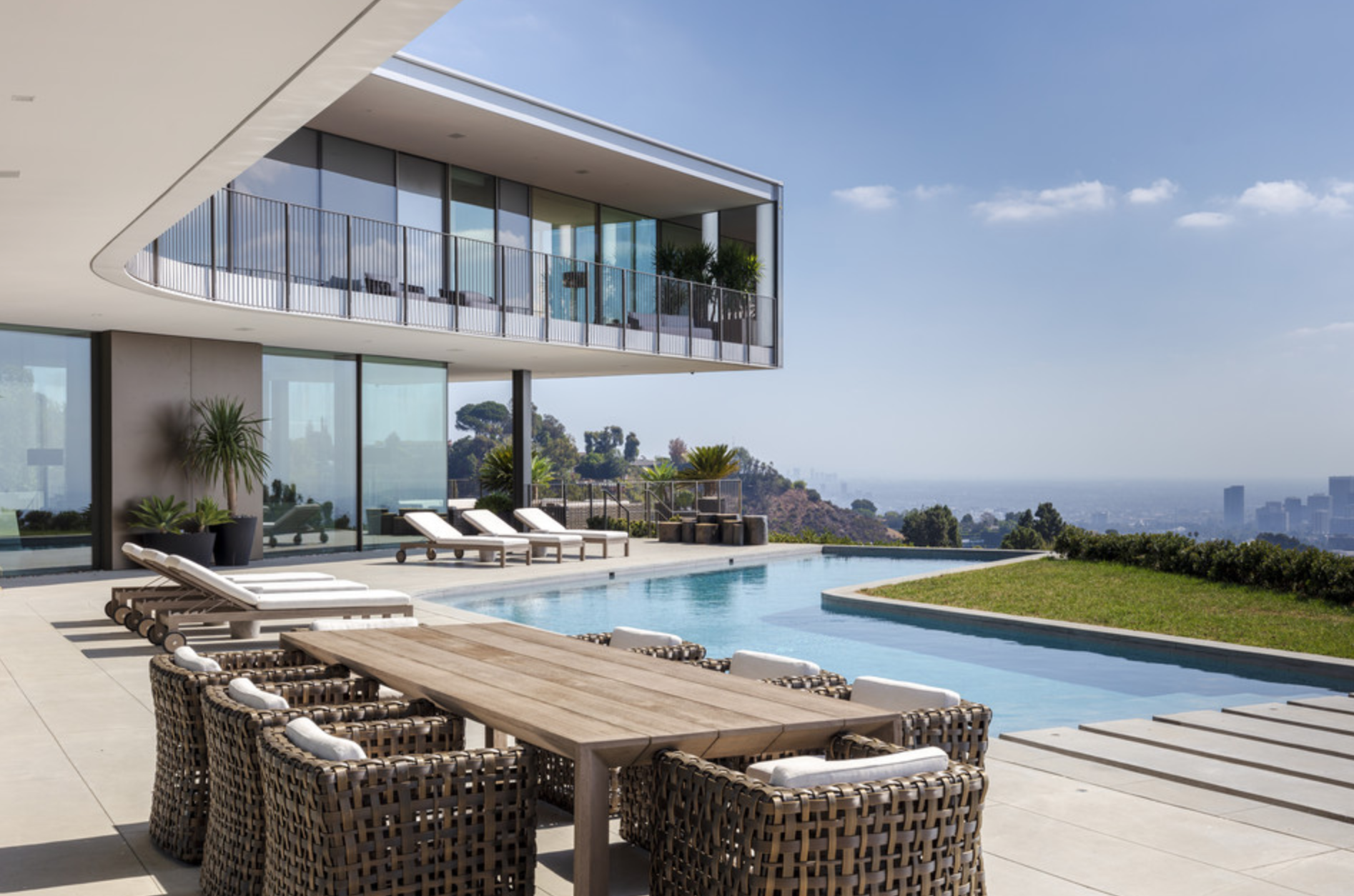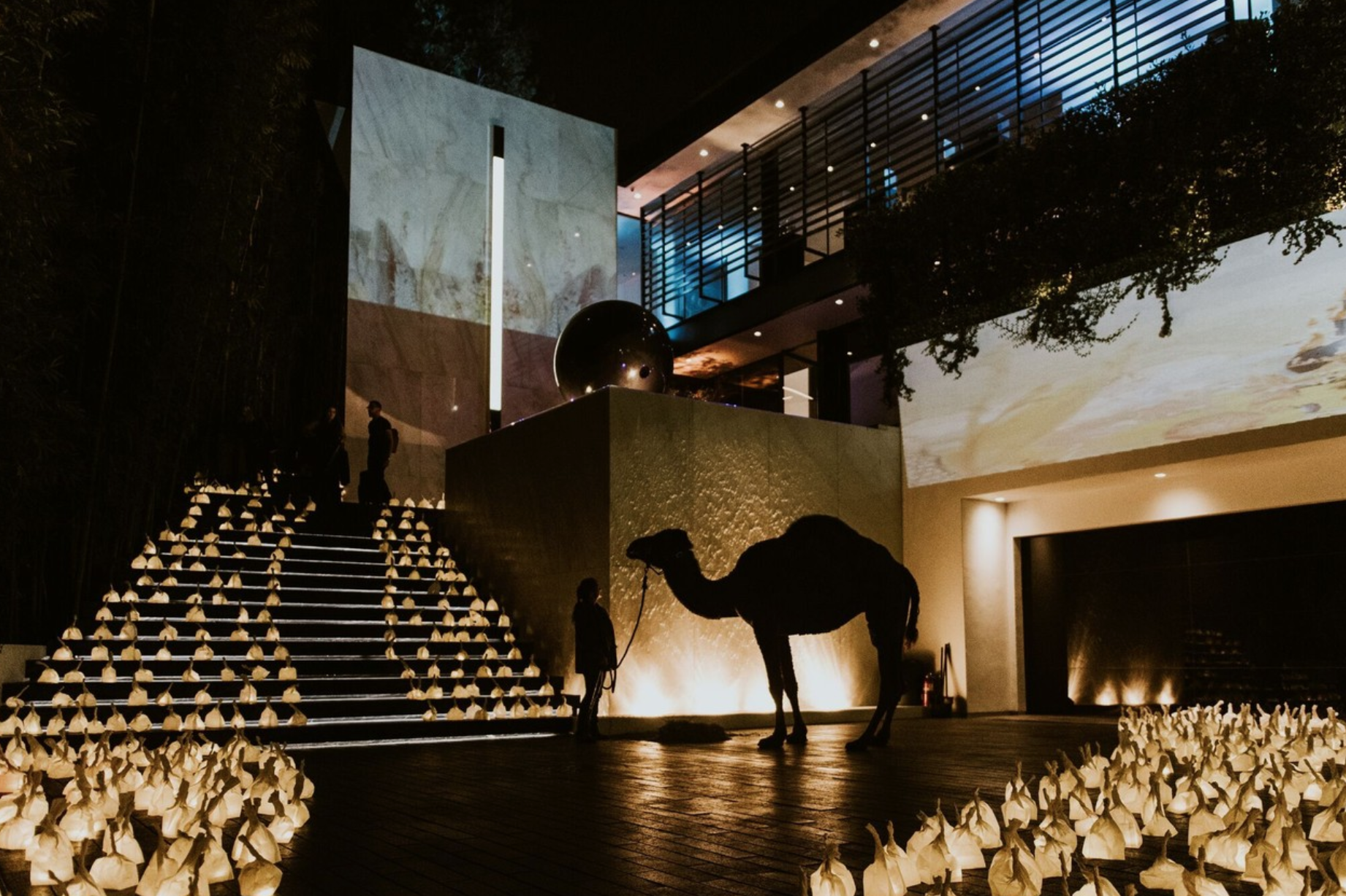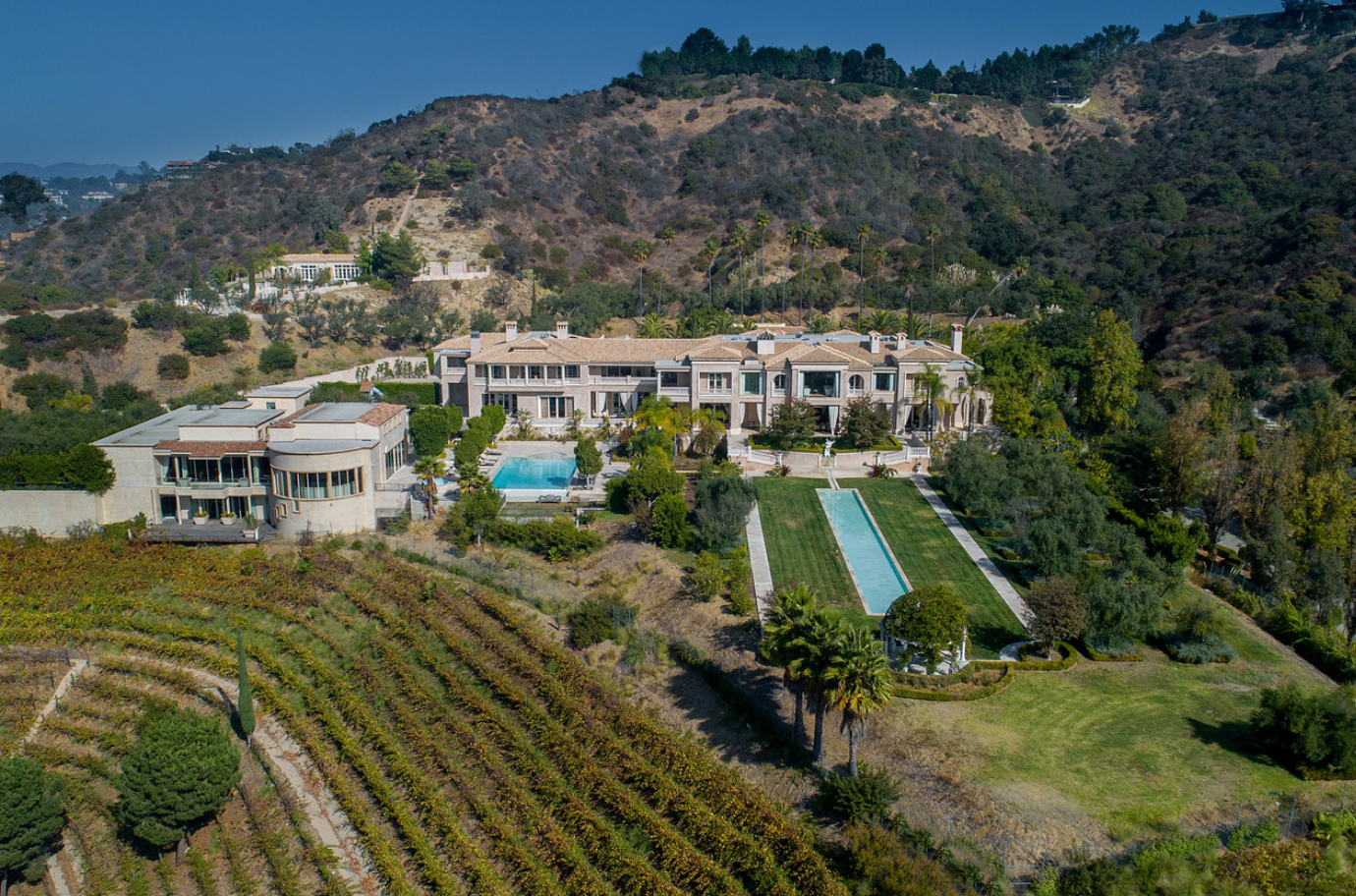Developers Have A Big Problem: Too Many New Mega-Mansions (#GotBitcoin?)
Builders and brokers are throwing blowout bashes and testing an array of marketing stunts amid the area’s spec home bubble. Developers Have A Big Problem: Too Many New Mega-Mansions (#GotBitcoin?)
Heavy duty vehicles line both sides of many of the winding two-way streets in the Hollywood Hills, making them treacherous single-lane thoroughfares. Construction workers wave stop signs as trucks laden with glass and steel back slowly out of driveways. Empty parcels of land all over Los Angeles’s poshest neighborhoods are being transformed into lavish mansions with price tags in the tens, or even hundreds, of millions.
“Every time I drive up there for any reason, if I return without getting my car dinged I breathe a sigh of relief,” says Andy Butler, a real-estate marketing consultant.
Real-estate experts estimate that there are about 50 ultra high-end spec houses under construction in the area, from Beverly Hills to Bel-Air and Brentwood.
The unprecedented wave of development has its roots in the heady days of 2014 and 2015, when foreign buyers poured into Los Angeles and luxury markets across the country logged record sales. A couple of local megawatt deals—including the $70 million sale of a Beverly Hills compound to billionaire Minecraft creator Markus Persson in 2014—inspired the construction of bigger and pricier homes, most of which were built as contemporary cubes. Some were built by inexperienced developers; many had price tags north of $20 million.
Now, there are simply too many, and not enough buyers to go around. “It’s created its own monster,” says Stephen Shapiro of Westside Estate Agency. “We have an enormous oversupply of these white boxes. There’s years of inventory out there.”
A review of the Los Angeles multiple listings service shows close to 100 homes on the market asking over $20 million in Los Angeles County, at least 35 of which could be classified as spec homes, and more are under construction. And those are just the listed ones: Appraiser Jonathan Miller says more than a third of homes in that price category are never entered in the MLS. Some of the city’s most expensive are notably absent.
The surplus mirrors a similar situation in New York, where high-end developers rushed to build pricey condos amid a market upswing, and are now faced with enormous competition for buyers.
But unlike New York, smaller, private lenders and wealthy individuals have provided much of the financing for the Los Angeles spec homes.

At A ‘Great Gatsby’ Themed Event To Launch A $35.5 Million Spec House, A Female Performer Poured Champagne While Hanging From A Trapeze.
Don Hankey, a California businessman known as the king of subprime car loans, says one of his companies has provided close to $300 million on high-end homes in the Los Angeles market, including on spec homes. Public records show Hankey Capital provided about $82.5 million in financing to “The One,” an almost-built megamansion by Los Angeles developer Nile Niami, who plans to list it for $500 million.
That asking price is more than twice the record paid for a home in the U.S., a record set earlier this year by hedge funder Ken Griffin’s purchase of a nearly $240 million penthouse in New York. The record price for a Los Angeles area home was set by the $110 million sale of a Malibu mansion in 2018.
“You have to be concerned,” Mr. Hankey says of the oversupply. “We’ve cut back. We’re not as aggressive in the financing.”
Other lenders on pricey spec homes include Axos Bank, formerly Bank of Internet, which financed a massive $180 million monolith built by plastic surgeon and newbie developer Raj Kanodia.
The debt load for developers can be substantial. “If I’m living in my house and I put it on the market for sale, I’m still living in my house,” Mr. Shapiro says. “These are empty houses, and the developer is spending a lot every month to keep them.”

Andy Warhol’s 1974, Two-Toned, Rolls-Royce Shadow Can Be Included In The Deal For A New Trousdale Spec Home That’s Branded Around The Artist.
In this environment, and amid signs that prices are falling, developers and their agents are going to extraordinary lengths to differentiate their listings from the pack. They are throwing themed bashes in lieu of traditional open houses, thinking up gimmicky new amenities and hiring marketing experts to reimagine homes as individual brands with their own names, logos and stories. Some developers are relisting plots of land, hoping to get their money out without sinking more money into construction.
“People come to us because they want to stand out,” says Alexander Ali, whose marketing and public relations firm the Society Group is finding a growing business in creating brands for megamansions. “There are so many new homes coming to the market every day.”
Mr. Ali’s latest exercise: Turning a roughly 7,600-square-foot contemporary home in Trousdale into “WARHOL 90210,” a property branded around artist Andy Warhol. Mr. Ali and the developer, Wystein Opportunity Fund, joined with a local gallery to display Warhol prints in the home. At a Warhol-themed disco to be held on site, a Warhol look-alike will be filmed striding through the party; the resulting video will be blasted out on social media. (The house has no connection to Mr. Warhol.)

Amid A Surplus Of Luxury Spec Homes, Developers And Their Agents Are Going To Extraordinary Lengths To Differentiate Their Listings From The Pack, Like Throwing Themed Bashes In Lieu Of Traditional Open Houses.
Mr. Ali convinced the agent that Mr. Warhol’s onetime car—a 1974, two-toned, Rolls-Royce Shadow—and the Warhol prints featured in the home should be included in the deal. “It defines the house as a collector’s dream,” Mr. Ali says. The whole package seeks $17.75 million. The house can be sold separately for $15.625 million.
In February, Mr. Niami threw an elaborate party inspired by Dutch artist Hieronymus Bosch’s painting “The Garden of Earthly Delights” in a home he is listing for $39.995 million. Its three levels were organized into heaven, earth and hell, and models in colorful tulle dresses swam in the property’s glass bottomed pool, said Mr. Ali, who organized the party.
There were actors posing as Adam and Eve while hosting a virtual reality game that allowed guests to enter a rendition of the Bosch painting. People drank whiskey infused with the body of a dead cobra, and dancing women dressed in leather, whips and chains. A camel stood at the entrance to greet guests.
In Bel-Air, real-estate brokerage firm the Agency recently threw a “Great Gatsby” themed event to launch a $35.5 million spec house. A female performer in a bedazzled costume hung upside down from a trapeze to pour champagne for guests, while another floated on the pool in a transparent bubble.
Mr. Ali says developers will pay anywhere from $20,000 to hundreds of thousands to throw such events.
In addition to the parties, developers are always on the hunt for creative new amenities. “It’s about the wow factor,” says spec home developer Ramtin Ray Nosrati, whose under-construction mansion in Brentwood includes a secret room for growing and smoking marijuana.
The ventilated room, accessed by hitting a button hidden inside a living room bookcase, will have tinted windows that darken for privacy. The house, slated to ask between $30 million and $40 million, will also come with a budget for an employee to supervise growing and harvesting. Mr. Nosrati compared the amenity to “having your own vineyard.”
Despite all this, price cuts are the order of the day. Bruce Makowsky, a handbag designer-turned-developer who sold the Minecraft property, lowered the price of his latest project, a lavish Bel-Air house with a candy room and a helipad, to $150 million, down from its original $250 million asking price. Mr. Niami slashed the price of a sprawling 20,500-square-foot house known as Opus to $59.995 million, down from $100 million.
Developer Ario Fakheri has chopped the asking price for his Hollywood Hills home with a roughly 300-gallon indoor shark tank to $26.995 million from $35 million.
Sales are still happening: Approximately 11 deals have closed for more than $20 million in Los Angeles so far this year, and a Saudi buyer recently paid $45 million for a spec home built by diamond manufacturer Rafael Zakaria. But sellers know they have the upper hand. “People are making lowball offers,” says Mr. Shapiro of Westside Estate Agency. “They’re not being shy.”
Doug Barnes, the founder of Eyemart Express, sold a contemporary home in Beverly Hills for $34.65 million in April, or nearly 40% off its original $55 million asking price, records show. British restaurateur and Soho House co-owner Richard Caring is listing a home he bought in Beverly Hills for $29.995 million; he paid $33 million for it in 2016, records show.
As for “The One,” the $500 million property was originally slated to come on the market in 2017 but has yet to be listed. The developer blamed construction delays.
Updated: 11-20-2019
Facing Real Estate Slowdown, Jeff Greene Regrets Building His Megamansion
The billionaire developer is planning to relist the property for $129 million amid a glut of ultraluxury properties in Los Angeles.
Over a decade ago, Jeff Greene earned a fortune betting against risky mortgages in the last housing market crash. These days, the billionaire is finding himself less lucky in a different real-estate investment—an enormous Los Angeles mansion that he is having trouble selling amid an oversupply of such homes.
Mr. Greene said he is planning to once again relist the Beverly Hills home for $129 million, down from its original $195 million asking price when he first listed it in 2014. “This house has been a terrible deal for me,” he said. “We’re into this thing for probably $80 million or $90 million at least. We’ll be lucky if we get our money back after years of carrying costs.”
“You never want to own the most expensive home in a town, because there are just too few buyers,” he added.
From a middle-class background, Mr. Greene built his real-estate business from scratch, starting out as a busboy at the Breakers hotel in Palm Beach, Fla. He made his fortune by betting against risky mortgages in 2006, a strategy shown to him by hedge fund-executive John Paulson.
Mr. Greene, 64, is also known for his interest in politics. He ran for Senate in Florida in 2010, and for its Governor last year. A resident of Palm Beach with his wife Mei Sze Greene and their three children, he is currently developing luxury residential projects in Los Angeles, New York and West Palm Beach.
Mr. Greene is hardly the only one having trouble selling a big Los Angeles property. Builders of some of the city’s grandest and most ambitiously priced estates have been significantly lowering their price tags in recent months as they contend with high mansion inventory and recession jitters.
In Holmby Hills, the mansion once owned by television producer Aaron Spelling sold last summer for $120 million, a significant reduction from the $200 million it sought in 2016. And in October, a home built by handbag entrepreneur Bruce Makowsky sold for $94 million, well off the $250 million it listed for in 2017, according to local agents.
On the whole, sales of Los Angeles homes priced at $10 million or more have taken a tumble over the past year, said Michael Nourmand of Nourmand & Associates, a luxury brokerage. His firm’s data shows that, in the first three quarters of the year, sales at that price point were down about 16% from the year prior. Mr. Nourmand attributed the drop to a decline in the number of foreign buyers active in the Los Angeles market, overpricing and an uptick in insurance prices in areas close to fire zones.
A few years ago, sellers were pricing far too ambitiously in a bid for attention, Mr. Nourmand said. Now, such properties are sitting on the market. “It’s understood that, at the very high end, the price is more of a suggestion than a firm price,” he said. “But days on market are a seller’s enemy.”
Jade Mills of Coldwell Banker Global Luxury, Mr. Greene’s agent, said buyers want to feel they have gotten a good deal. “I talked to one of the sellers who sold a very big property. He said to me, ‘This has been a learning experience. Even the wealthiest people in the world want to feel like they’re getting value,’” she said.
Mr. Greene bought his Beverly Hills estate out of receivership for $35 million in 2007 from Saudi businessman Mishaal K. Adham and his wife while it was under construction. He then plowed tens of millions into completing the house, which was only 30% finished, he said. The property has two bowling alleys, a theater that seats 50, a discothèque with a rotating dance floor, a hammam Turkish-style bath and a 24-car garage. The property also has 6 acres of vineyards and a wine cellar, below right.
Mr. Greene and his family have only spent about two weeks there in the past year, he said, noting that he considers the whole project a mistake. “I totally regret it, wish I never did it,” he said, noting that he first saw the property in the newspaper. “I thought it was a deal. I’m thinking ‘Wow, this will be cool. Let’s try living in a giant big mansion.’ I don’t even like sleeping in the place. It’s too big.”
Mr. Greene said he hopes the 25-acre compound, known as Palazzo di Amore, will appeal to a buyer who wants a swath of land and lots of privacy, rather than a contemporary glass box wedged into the Hollywood Hills.
When you watch the old movies, you think of the giant gates that open and you go up some long beautiful driveway through the trees to a wonderful courtyard,” he said. “That’s people’s expectation when they’re writing giant checks for homes. I can go for a walk on that property for 45 minutes without even duplicating my steps.”
Mr. Greene noted that the overdevelopment of luxury homes extends across the country to New York, where he is building a high-rise condo project. It’s never been so important to have “staying power,” he said.
“If somebody has to sell today and they have high end real estate, they’re probably in panic mode and they should be in panic mode,” he said.
Updated: 7-1-2020
Nile Niami Is L.A.’s Megamansion King. Has He Built A House Of Cards?
The brash California developer just unveiled The One, his $500 million project. But he must battle mounting financial pressure across his portfolio.
Standing on a grassy knoll in a tightfitting V-neck T-shirt and gold-rimmed aviators, views of the Los Angeles basin and a cluster of sunbathing women sprawled out behind him, developer Nile Niami looked every bit the king of the city’s megamansion scene.
“Seven years ago, I had an idea to create the biggest, most expensive house in the urban world,” he boasted in a video posted to his roughly 60,000 Instagram followers last month. “And I did it.”
Almost. The house—a mammoth, roughly 100,000-square-foot Bel-Air spec mansion listing for $500 million—is still unfinished. Originally slated for completion three years ago, the home, called “The One,” has been beset by years of financing and construction delays.
The pool is an empty concrete hole, the video shows; the moat carved into the perimeter is also dry. Plans for a room with walls made from jellyfish tanks and a Monaco-style casino haven’t come to fruition so far. Mr. Niami’s newly launched social media campaign calls for about 200 Instagram influencers to market the property on their social media. If any of them find a buyer, they’ll get $1 million, he said.
Promoting such a pricey home before it is completed is an unusual move, but Mr. Niami is in unusual circumstances: He faces an October repayment deadline for an $82.5 million loan on the property.
Mr. Niami said he launched the campaign to “see what happened,” and that it is unrelated to his coming repayment. He attributed the construction delays to financing issues.
“There were a lot of times in this process where I had to stop because I never had financing,” he said, noting that he funded the construction in the early days using proceeds from the sales of previous projects. He is thinking of scrapping the jellyfish room. “I didn’t think it was going to be $1 million to buy jellyfish,” he said.
It isn’t just The One: Many industry executives believe Mr. Niami is in financial straits across his portfolio after piling debt onto a string of ultramodern glass boxes built over the past few years and pitched with over-the-top decadence. Now, he’s up against changing architectural tastes, competition from other developers and the pandemic, which has made would-be buyers more anxious about the economy.
Mr. Niami hasn’t sold a major project since 2017. He has at least five other unsold megamansions, each seemingly more extravagant than the last, with champagne vaults, private nightclubs and, in one case, a room with red walls and erotic paraphernalia. Building these palatial estates, collectively valued at roughly $700 million, has left him shouldering hundreds of millions in outstanding loans, mortgage records show.
In April, a lender on his 14,000-square-foot West Hollywood house situated just above the Sunset Strip filed a notice of default against Mr. Niami, property records show, and the developer has already turned the keys over to his lender on Opus, a Beverly Hills mansion that came on the market for $100 million in 2017.
Mr. Niami said the West Hollywood default has been resolved and was part of a disagreement over his interest rate at the property. An attorney for the lender—a company linked to wealthy Canadian investor Lucien Remillard—disputed that claim, saying the matter hasn’t been resolved and “the foreclosure process continues.”
Mr. Niami denied that his empire is in trouble, saying he had 17 financially qualified parties inquire about The One following his social media campaign, and that he had multiple offers on other homes in the past few months, including bulk offers for several homes.
He said he is considering whether to accept the offers and may opt to take the properties off the market permanently and repitch them as high-end short term rentals.
Mr. Niami is known for his flamboyant lifestyle, designer cars and entourage of beautiful women.
Earlier this month, he posed for pictures at one of his projects, a $65 million house in Bel-Air, in just a fur coat and Calvin Klein boxers, holding a bottle of tequila in each hand; he was appearing in a music video with Blac Chyna, an actress and musician.
In the past roughly two years, he’s also posted pictures and videos of himself racing Bugatti and Pagani sports cars, ordering Moet & Chandon Champagne in a pool on the Greek island of Mykonos, driving all-terrain vehicles in Marrakesh, flying private and posing in a leopard print sarong at the Burning Man festival in Nevada.
He recently allowed Unruly Agency, a modeling and marketing company, to use two of his Bel-Air homes to shoot sexually suggestive content. Models posted images of themselves posing in string bikinis, pouring water on themselves while leaning on the hood of a vintage Malibu Chevrolet. One model later posted explicit videos of herself at the property on a pay-per-view website popular with adult entertainers.
His bombastic nature has sometimes drawn the ire of his lenders. After posting a video of himself passionately kissing his girlfriend at a restaurant on Instagram this week, he said he got a text from one of his bankers asking him to remove the post. “He’s like, ‘You’re trying to sell a $500 million house.’”
Mr. Niami declined: “I’m like, ‘No, Dude, the world needs love right now,’” he said.
Mr. Niami plans to pitch a show about himself to Netflix. “I’m working on a show right now that’s like the super super good guy of Tiger King but not about murder.
It’s about me and my crazy life and what I do post-Covid to solve things,” he said, “and how I’m just a terrific guy that helps people and has fun.” He added: “Post Covid, people want a hero that they can cheer for that every girl wants to be with, every guy wants to be like.”
Mr. Niami grew up in a poor area of the San Fernando Valley. His mother, a special-education teacher, was murdered by a home intruder in 2001.
His first career was in Hollywood. Mr. Niami worked in special effects makeup before starting his own production company, producing independent films such as “The Watcher,” a 2000 movie which starred Keanu Reeves.
Saying he got the idea of flipping homes from infomercials, Mr. Niami got into the real-estate industry in the 1990s, buying up homes cheaply following the devastating Northridge Earthquake. He worked with insurance companies to redo and flip homes in the area. He soon graduated to bigger and bigger homes and attracted financing.
By the early 2010s, Mr. Niami was building contemporary homes in some of Los Angeles’s priciest neighborhoods. In 2012, he sold a house for $18 million to the Winklevoss twins, known for battling Mark Zuckerberg over ownership of Facebook.
In 2014, he sold a Holmby Hills mansion with an underwater tunnel to rapper P. Diddy for $39 million, followed in 2016 by the $38.27 sale of a mansion in Beverly Hills to billionaire private-equity executive Brian Sheth, the co-founder of Vista Equity Partners. The next year, he sold a renovated Beverly Hills home to boxer Floyd Mayweather for $26 million.
Irish architect Paul McClean, who designed a number of Mr. Niami’s homes, said the developer “correctly identified” an emerging market for ultra-high-end contemporary homes.
His properties were tricked out with more over-the-top amenities and gadgets than other expensive homes. “The timing was super fortuitous,” Mr. McClean said. “He was struggling to finance his projects back in 2011, but by the time they came on the market they were selling like hot cakes.”
Perhaps Mr. Niami was too successful: Soon, others were emulating his style and the market became awash with mansion projects dotting the hills. “I’m like the original Prada. Many people out there are like the Prada knockoff from Hong Kong,” he said. At the same time, real-estate veterans say Mr. Niami began taking on more and more houses at once, piling on debt and tackling ever pricier projects.
Traditional banks are reluctant to issue superjumbo loans on single-family home projects, particularly speculative ones like Mr. Niami’s, so the developer heavily relies on a small network of private lenders. In addition to loans from First Republic Bank, records show a series of loans provided by companies linked to Mr. Remillard and his son Julien Remillard.
The Remillards and Mr. Niami have known each other for decades and worked together when Mr. Niami was in the film business.
The $82.5 million loan on The One was provided by a company tied to Don Hankey, a California businessman known as the king of subprime car loans who told The Wall Street Journal in 2018 that he had provided close to $300 million on high-end spec homes in Los Angeles. In an email, Mr. Hankey said he felt comfortable with his basis on the loan and optimistic about the market.
“Money was chasing him. It was too easy to get the money,” said Stephen Shapiro of Westside Estate Agency, a Southern California agent who doesn’t represent Mr. Niami.
As the market slowed over the past few years, some of Mr. Niami’s investors grew frustrated that he hasn’t sold a number of the homes; Mr. Niami denies his investors feel any such frustration. He confirms turning away offers on some of them.
Chinese mobile gaming billionaire William Ding made a nearly $50 million offer to buy Opus, the Beverly Hills property asking $100 million, earlier this year, but Mr. Niami refused to take it.
“It wasn’t enough money,” Mr. Niami says of the offer. “I’m not going to…build it for four years and not make anything. It’s not worth it.” In February, lender Joseph Englanoff, a doctor turned real-estate investor, took ownership of the house.
Dr. Englanoff didn’t respond to requests for comment. Mr. Niami declined to comment on how much, if any, cash had actually changed hands as part of the transaction, or if the deal was a form of debt cancellation.
Richard Saghian, the chief executive of online fashion giant Fashion Nova, made a more than $40 million offer for the West Hollywood house when it first came on the market and was turned down, said another person familiar with the situation.
In April, a limited-liability company tied to Lucien Remillard filed a notice of default on that property. The lender cited an unpaid balance on the property of $10 million plus interest and late charges, mortgage records show.
Mr. Niami has traditionally taken a “sex sells” approach to marketing his homes. In a listing video for Opus, scantily clad women covered in gold paint and chain mail writhe around the house and pose around a gold Lamborghini Aventador.
Local agents said the approach may have been successful a few years ago, but now risks alienating more conservative shoppers and families who have made up an increasing number of purchasers of homes in the area over the past year.
Many agents also say buyers are starting to gravitate toward more classic architecture and pedigree, rather than to the kind of contemporary glass box homes for which Mr. Niami is known.
Mr. Niami noted that some contemporary glass homes have traded for big numbers over the past year. “Everything else is selling apart from my stuff,” he said.
Some agents say it is unwise to bet against Mr. Niami. “Remember, in the high stakes game of trophy properties, one sale can make or break somebody.
One big deal can bring someone back to the top quickly because the margins on these are millions and millions of dollars,” said Josh Altman of Douglas Elliman, the listing agent for the West Hollywood property.
Certainly, The One is unlike anything that has come before it. The behemoth mansion has a 50-car garage, a 10,000-bottle wine cellar, a four-lane bowling alley, a skydeck with a putting green, five elevators and a private nightclub with seating pods that appear to float on the surface of a large infinity pool.
The house has garnered a slew of conflicting opinions from local luxury agents. Some say it is the most spectacular house ever built, others say it looks more like something built by the Army Corps of Engineers. The home isn’t exactly the biggest in the world; it is dwarfed, for example by London’s Buckingham Palace and the Apostolic Palace in Rome, where the pope lives.
Following the completion of the project, Mr. Niami said he’s getting out of the real-estate business, “I may do one or two more houses after this but I’m not going to do the level of houses I’m doing now. It’s too much stress,” he said. “I’m exhausted.”
Updated: 7-2-2020
Elon Musk Strikes Deal To Sell Multiple Homes In Los Angeles
The Tesla founder has penned an agreement to sell several multi-million-dollar properties in Bel-Air to an entity led by developer-designer Ardie Tavangarian.
Tesla boss Elon Musk is another step closer to fulfilling his pledge to “own no house.”
Los Angeles developer Ardie Tavangarian, who last year sold a lavish megamansion for $75 million, has struck a deal to buy several Los Angeles properties from Mr. Musk, the developer’s company, Arya Group, said in a statement Wednesday evening.
Mr. Musk, 49, signed a letter of intent to sell the properties to Arya Chalon LLC, a new entity created by Mr. Tavangarian, which will redevelop the properties into “a new single development project to make it truly one of a kind,” according to the statement from Arya Group, which declined to disclose the agreed-to sale price.
The deal is for a set of four homes Mr. Musk listed together in May for a combined $62.5 million. They include a four-bedroom mansion on Chalon Road, plus three substantial houses on Somera Road, located on the hillside above the Chalon property.
Mr. Musk put more than $100 million worth of California real estate on the market in mid-May, after an impromptu announcement on Twitter that he would sell most of his physical possessions.
“Don’t need cash,” he wrote in a follow up Tweet. “Devoting myself to Mars and Earth. Possession [sic] just weigh you down.”
He made history the same month, when SpaceX, the aerospace company he founded, launched NASA astronauts into space from U.S. soil for the first time in nearly a decade.
Besides the $62.5 million development opportunity, Mr. Musk also listed two other mansions on Chalon Road, one of which he reportedly sold this month to Chinese billionaire William Ding for $29 million. The other, a white-shingle ranch and the longtime home of late actor Gene Wilder, is still on the market for $9.5 million.
Mr. Musk also owns a historic 47-acre estate in Hillsborough, California, near San Francisco, which he purchased a few years ago for $23.364 million, according to property records. He’s now asking $35 million for the house.
The billionaire’s fortune has bloomed over the past year to a total of $51.7 billion, according to Bloomberg, which first reported the multi-property deal.
Mr. Musk did not immediately return a request for comment.
Related Articles:
Home Sellers Now Use Spycams To Gather Intel On Prospective Buyers
Home Prices Continue To Lose Momentum (#GotBitcoin?)
Freddie Mac Joins Rental-Home Boom (#GotBitcoin?)
Retreat of Smaller Lenders Adds to Pressure on Housing (#GotBitcoin?)
OK, Computer: How Much Is My House Worth? (#GotBitcoin?)
Borrowers Are Tapping Their Homes for Cash, Even As Rates Rise (#GotBitcoin?)
‘I Can Be the Bank’: Individual Investors Buy Busted Mortgages (#GotBitcoin?)
Why The Home May Be The Assisted-Living Facility of The Future (#GotBitcoin?)






Leave a Reply
You must be logged in to post a comment.